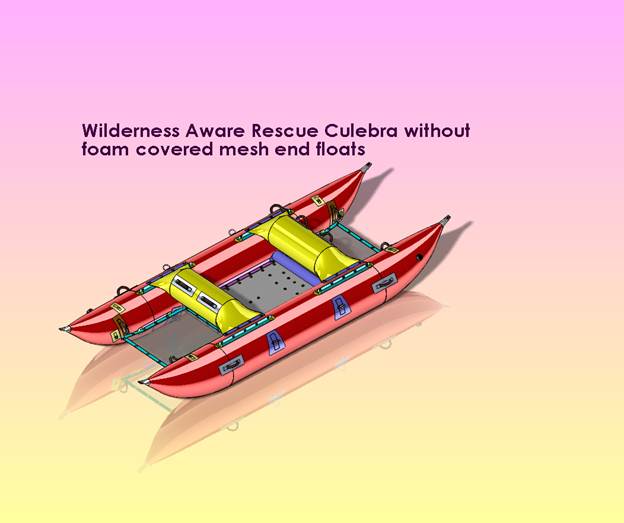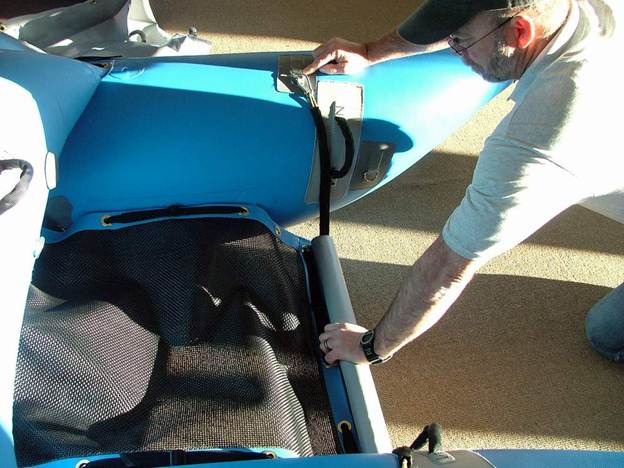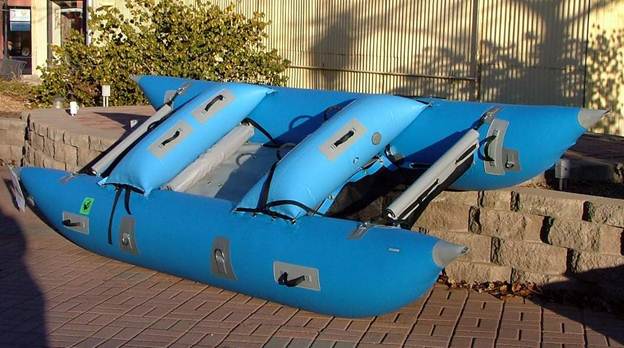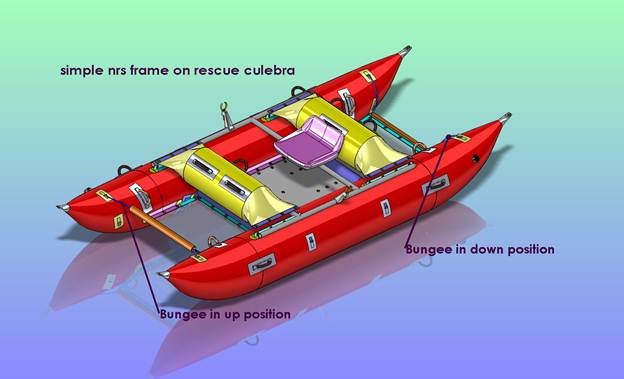Here is the History of the rescue culebra - frameless rescue catartaft
The first time we decided to go to the Gauley Fest in West Virginia, the year was 2002. We wanted to show a boat that east coast customers would like, and customers had been asking us to make a shredder like model. I wanted to improve on the shredder concept because it looks like it takes all the good qualities of a cataraft and makes them worse with cross tubes. This is all for the process of removing a frame from the tubes by using a cross tube system. So naturally if one wanted to do that they would put the cross tubes in the middle of the main tubes and hook them together. My thought was to put the cross tubes on top of the main tubes. This system allows most of the energy in a reversal to move through the boat instead of hitting a cross tube. If the cross tube is not stopping the forward progress of the boat, It is going to move more freely through the river with less effort, and stability. The cross tubes are shaped to form an air structure that replaces the curved metal framework of a yoke type metal frame. It does this by air and strap tension between 2 inch stainless steel D ring patches on the underside of the cross tubes and the main tubes, and a Grommet strip on the end of the cross tubes and on the main tubes.
The first day it went on the upper Gauley, the cross tubes were a success. It also had a mesh floor. However the mesh floor idea flopped. The solid floor with a few bail holes and a grommet strip around the perimeter was a much better idea. With this concept the waves actually push the boat up into the air.
One can see the mesh floor and the cross tube at work, on this picture from the first trip down the Upper Gauley. http://www.jpwinc.com/images/pillow1email.jpg
One can see the effect of the solid fabric floor in this picture of us catching air in the Culebra Grande at Hermit rapid in the Grand Canyon. http://www.jpwinc.com/images/cgherm2em.jpg
The performance issue here is the perfect balance between raft and Cataraft, and how these different systems move through the water. Catarafts have little resistance to waves except the face that the tubes present. Rafts have a large face that is presented to the river and to waves. A cataraft moves through the waves more than a raft, and a raft moves on top of the waves more. The trick in performance is to get a boat that moves through the waves enough, and ontop of the waves enough. This allows a shorter leanrning curve, allows a smaller craft to run larger waves, and still gives a good ride when the waves push the floor and the boat upward. These designs have had to be refined, especially in the respect to staying in the boat, foot cups vs foot thwarts and things like that. Please follow this link if you would like to know more about foot thwarts and how they work.
Read what Dr. Tom Zimmer says about the culebra. He took the boat down the Gunnison George, down Gore Canyon, and even Pine Creek on the upper Arkansas drainage. Tom is a professor of Outdoor Recreation at Wyoming Catholic College.
http://www.jpwinc.com/pages/rr-24.html
One of our first customers did an ice rescue of a lab retriever up near Gresham Or. They pushed the boat out until the ice beneath the rescuer’s feet cracked, then he dove into the cockpit, rescued the lab and then was pulled back by a tether. This was the Gresham fire district in Gresham Oregon. It was on the local news channel, but I did not get a copy of the tape. That was when I realized that this boat had a lot of rescue potential. We made a framed model for a fellow involved in rescue 3. His name was Dr Mike Crosline. He claimed to be involved with Rescue 3 and he had some great ideas. I believe that it was tested on an actual rescue, and he said that the boat was used to rescue someone off of a car that had been caught in a flash flood. I have no actual documentation.
Alex Michael from Mild to Wild asked us to make a drop stitch panel that could be dropped from a high position in a daddy cat cataraft module. It had handles on it, and a person could self-rescue between the tubes on the cat. This was tried out for an entire year, and it worked well.
Then in 2009 at the America Outdoors show, Jack Gunkle form Wilderness aware approached us with an idea to make a rescue craft that swimmers on the Arkansas could use to self-rescue. Alex, Joe Griener, and Jack Gunkel were all at this meeting, and with their combined experience we came up with this rescue cat Idea. However this boat had a mesh floor that either stayed flat, or stayed up. The extended flat rescue position scooped water and made the performance sluggish. WA crew members always preferred to have the floor tied up. This is the video of an actual rescue with the floor extended.
http://www.youtube.com/watch?v=9NveYBFRW0I
In early 2011, we made two boats for Clear Creek rafting. We have decided that the mesh on the front had to be suspended with a bungee cord that was inside of tubular web. The end was suspended inside of a pvc pipe that had a large amount of foam wrapped around it. We thought that the flotation provided by the foam was a good idea. Since the bungee cord could not go down very low because of the tubular web constrained it to a certain height, this amount of foam did not need to exist, and was causing the swimmer to have problems getting into the mesh compartment. This year we have reduced the amount of foam, and it is easier to get into the mesh compartment.
The original Wilderness Aware Rescue Culebra

These are the changes that we made in 2011

Here are the changes to the foam block we made in 2012.
Note that the tubular web is not sewn properly around the carabineer. The tubular web is supposed to restrict the stretch of the bungee that is inside of it. Errol took this picture before we were finished with the project.

And the finished product

One other feature is a simple frame so this boat can be rowed by one person
. 
The frame is tied on the outside with d rings. We do not think that the d rings are necessary because the frame can be strapped to the grommet strips on the inside of the floor. Some people think the d rings get in the way when it is paddled. The frame is shown here on the model with the new smaller foam casing around the bungee tube.
Vince Moffit is another rescue 3 person who has been involved in the 4 corners area of the USA for a long time. He is using this in his instructions. I check in with him from time to time. We just sent him the latest model also. We keep in touch with Vince, and expect good feedback.
As you can see from the model that there are plenty of handles and attachments. People tend to want to use the boat for recreation, and the folks at Clear Creek and Wilderness Aware have boatmen who really like serving as the rescue boat because it is fun. They can pick up numerous people with this craft, and they do not have to put down the paddles or the oars to do it.
As you can see from this document, there has been a lot of collaboration on this project from people who know a lot more about rescue that we do.
Edrawings and Collaboration on Design:
I would highly suggest that you go to this web site and download a program that will allow you to zoom in and out and spin a 3 d model of this boat around on your computer screen.
The program is called Edrawings, and it is available for free from Solid works.
Get the free program for windows here
http://www.edrawingsviewer.com/pages/products/SolidWorks-Viewer.html
Get the free program for mac here
http://www.edrawingsviewer.com/MAC_Viewer.html
Read more about the viewer and some of its functionality here
http://www.jpwinc.com/pages/solidworkssoftware.html
Here are some steps to get started with E drawings.
Get the viewer downloaded, start the program. Then go to this culebra specification table where you can view Jpeg files on the left column, and download edrawing files in the center.
Open up any file that you downloaded with the viewer program. Push the play button. Or you can read more at the site above. Usually the play button is a great first time look at the capability of edrawings.
In summary:
Our Culebra Frameless catarafts are a collaborations from many different individuals with different skill sets. Ours happens to be building inflatables, and design. We do not have the knowledge base required to put a rescue system together, unless we get help from qualified people who have been involved in rescue service. We have appreciated the help of those individuals named above, and seek continued input on the product. Using Edrawings to become aware of the changes has been a wonderful way to draw out the information from very talented people in the whitewater and rescue industry. We encourage anyone interested in the collaborative design process to check out Edrawings, and this design.
Well that is the evolution of the rescue culebra. There is more at this web site if you care to visit it. It is the culebra specification table
Thank you for reading this, and taking an interest in our products.
Jack Kloepfer, and the Crew at Jack's Plastic Welding inc.
See how foot thwarts help hold passengers in the culebra , and in self bailing rafts.
home | products | pictures & information | find a dealer | river stories & testimonials | related info | FAQ | contact us
Order inquiries: shop.jpwinc@gmail.com
Custom & Prototype inquiries: pschoser.jpwinc@gmail.com
© 2011 Jack's Plastic Welding, Inc
Toll Free 1-800-742-1904
P. 505-334-8748, F. 505-334-1901
